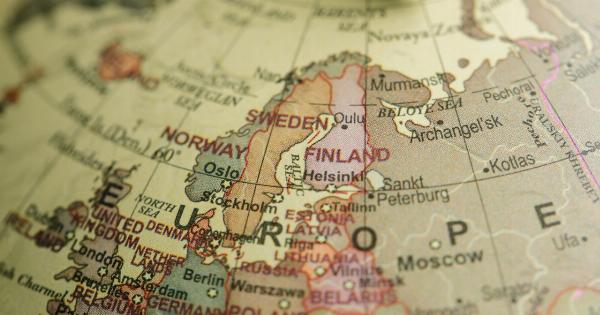Infertility is a global concern that affects millions of couples and individuals around the world.
While there are many factors that can contribute to infertility, including age, genetics, and lifestyle choices, recent studies have shown noticeable differences in fertility rates among European countries. In this article, we will explore the countries in Europe with the lowest fertility rates among men and delve into the possible reasons behind this trend.
1. Spain
Spain has one of the lowest fertility rates in Europe. According to recent data, the average number of children born to Spanish men is just 1.33, well below the replacement level of 2.1.
This decline in fertility can be attributed to several factors, including delayed marriages, economic instability, and a cultural shift towards smaller families. High unemployment rates, particularly among the youth, have discouraged many Spanish men from starting families.
2. Italy
Italy is another European country facing demographic challenges due to low fertility rates among men. The average number of children per man in Italy is 1.34, making it one of the least fertile countries in Europe.
Economic uncertainty, a lack of family-friendly policies and inadequate support for working parents are some of the key reasons behind Italy’s fertility decline. Italian men, like their Spanish counterparts, are also delaying marriage and childbearing in pursuit of career opportunities.
3. Portugal
Portugal’s fertility rate is similarly low, with an average of 1.30 children per man. The economic crisis that hit Portugal in recent years has had a significant impact on the country’s fertility rates.
High unemployment rates and limited job prospects have led many Portuguese men to postpone starting families. Societal pressure to achieve financial stability before parenthood, combined with the lack of supportive policies, has resulted in a decline in birth rates among Portuguese men.
4. Greece
Greece is also grappling with low fertility rates, as men in the country have an average of only 1.30 children.
The economic recession that struck Greece in the late 2000s and subsequent austerity measures have played a crucial role in discouraging family formation. Skyrocketing unemployment rates and widespread financial insecurity have deterred many Greek men from becoming fathers. The high cost of living and limited job opportunities have perpetuated this trend of low fertility rates.
5. Germany
Germany, despite being Europe’s largest economy, struggles with one of the lowest fertility rates among men at 1.57 children per man.
The country has faced difficulties in reconciling work and family life, with long working hours and limited parental leave options. The lack of affordable childcare options and cultural barriers that discourage men from taking active roles in child-rearing further contribute to Germany’s low fertility rates.
Additionally, a societal shift towards individualism and career-driven lifestyles has influenced German men to prioritize professional ambitions over starting families.
6. Switzerland
Switzerland, known for its high living standards and strong economy, surprisingly has one of the lowest fertility rates in Europe. The average number of children per Swiss man is 1.54, considerably below the replacement level.
Similar to Germany, Switzerland faces challenges in achieving work-life balance due to demanding work schedules and a lack of family-friendly policies. The high cost of living and limited financial stability also play a role in deterring Swiss men from embracing fatherhood.
7. Austria
Austria experiences a decline in fertility rates, with men having an average of 1.47 children.
The country’s social and economic environment, including high costs of living and limited career opportunities, influence Austrian men to prioritize other aspects of life over starting a family. The lack of comprehensive family policies, such as affordable childcare and parental leave options, further contribute to the low birth rates in Austria.
8. Czech Republic
The Czech Republic is also among the European countries with lower fertility rates. Men in the country have an average of 1.54 children, which is below the replacement level.
Factors such as economic uncertainty, inadequate family support policies, and societal expectations for financial stability before parenthood contribute to the decline in fertility rates among Czech men. Additionally, the availability of contraception and women’s increasing participation in the workforce have affected family planning decisions.
9. Slovenia
Slovenia has experienced a decline in fertility rates over the years, with men having an average of 1.57 children.
Economic instability, limited career opportunities, and a lack of supportive family policies contribute to the country’s low birth rates. The competitive job market and societal pressure to prioritize professional aspirations have led Slovenian men to delay family formation.
10. Poland
Poland, a country with conservative values and strong Catholic traditions, faces declining fertility rates among men. The average number of children per Polish man is 1.54, falling significantly below the replacement level.
Economic factors, such as limited job opportunities and low wages, alongside a lack of comprehensive family support policies, have contributed to this decline in fertility. Cultural expectations of financial stability and the traditional division of gender roles also influence family planning decisions in Poland.
Conclusion
The low fertility rates among men in several European countries highlight the complex interplay of socioeconomic, cultural, and policy factors that shape family formation decisions.
Economic uncertainty, limited job prospects, inadequate family-friendly policies, and sociocultural shifts towards individualism and career-driven lifestyles all contribute to the declining birth rates across Europe. Addressing these challenges requires a comprehensive approach involving supportive family policies, improved work-life balance, and efforts to counteract cultural norms that discourage parenthood.






























